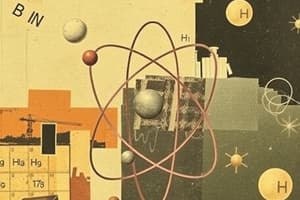Podcast
Questions and Answers
How many electrons can the first shell of an atom hold?
How many electrons can the first shell of an atom hold?
- 4
- 2 (correct)
- 1
- 6
What determines an atom's chemical identity?
What determines an atom's chemical identity?
- Atomic number
- Neutrons
- Electrons
- Protons (correct)
What is the nucleus of an atom composed of?
What is the nucleus of an atom composed of?
- Protons and neutrons (correct)
- Neutrons only
- Protons and electrons
- Protons only
Which subatomic particle influences an atom's mass and stability?
Which subatomic particle influences an atom's mass and stability?
What happens when an atom gains or loses electrons?
What happens when an atom gains or loses electrons?
Why are elements arranged in columns on the periodic table?
Why are elements arranged in columns on the periodic table?
Why do elements in the same column exhibit similar chemical behaviors?
Why do elements in the same column exhibit similar chemical behaviors?
What type of bond results from atoms sharing electrons in their outermost shells?
What type of bond results from atoms sharing electrons in their outermost shells?
How are ions formed in ionic bonding?
How are ions formed in ionic bonding?
What is a Lewis structure used for in chemistry?
What is a Lewis structure used for in chemistry?
How does quantum mechanics help explain atomic structure?
How does quantum mechanics help explain atomic structure?
What is the foundation for applications such as spectroscopy and nuclear chemistry?
What is the foundation for applications such as spectroscopy and nuclear chemistry?
Study Notes
Atomic Structure: The Building Blocks of Chemistry
At the heart of chemistry lies the concept of atomic structure, which describes the organization and behavior of matter's most fundamental building blocks: atoms. Atoms are composed of three types of subatomic particles: protons, neutrons, and electrons. Understanding atomic structure provides the foundation for explaining chemical reactions, the periodic table, and the properties of elements.
The Nucleus
At the center of an atom is the nucleus, which is composed of protons and neutrons. Protons, with a positive charge, determine an atom's chemical identity, and neutrons, with no charge, influence the atom's mass and stability. The number of protons in an atom's nucleus is called its atomic number, and it uniquely identifies each element on the periodic table.
Electrons and Orbitals
Electrons, with a negative charge, are found orbiting the nucleus in distinct energy levels, or shells. The first shell can hold up to two electrons, the second shell up to eight, and subsequent shells can also hold up to eight electrons. When an atom gains or loses electrons, it becomes an ion, which influences its chemical properties.
The Periodic Table
The periodic table arranges elements based on their atomic number, with each column grouping elements having similar chemical properties. This organization reflects the arrangement of electrons in atoms' outermost shells. For example, elements in the same column often exhibit similar chemical behaviors due to having the same number of valence electrons in their outermost shell.
Ionic and Covalent Bonding
Atomic structure also helps explain the types of chemical bonds that form between atoms. Ionic bonds result from the transfer of electrons between atoms with different electronegativities, leading to the formation of ions. Covalent bonds, on the other hand, form when atoms share electrons in their outermost shells, creating a stable electron configuration.
Molecular Structure
In more complex compounds, the arrangement of atoms within molecules results from the formation of covalent bonds. The Lewis structure, a diagram that represents the valence electrons in a molecule, is a useful tool for predicting molecular geometry and bond polarity.
Atomic Spectra and Quantum Mechanics
The behavior of electrons within atomic structure can also be explained using quantum mechanics, which describes the wave-like nature of particles. When atoms are subjected to high-energy radiation, such as ultraviolet light, they emit light at specific wavelengths, forming spectra that can be used to identify elements.
Applications of Atomic Structure
Atomic structure provides the foundation for many applications in chemistry, including spectroscopy, nuclear chemistry, and the development of new materials and technologies. For example, researchers use atomic structure to design new pharmaceuticals, develop advanced materials, and understand the behavior of substances in various environmental conditions.
In summary, atomic structure provides the foundation for understanding chemistry, offering insights into the behavior of matter and the formation of chemical bonds. By understanding the arrangement and interactions of protons, neutrons, and electrons in atoms, we can predict and explain the properties of elements and compounds.
Studying That Suits You
Use AI to generate personalized quizzes and flashcards to suit your learning preferences.
Description
Test your knowledge on atomic structure, the nucleus, electrons, the periodic table, chemical bonding, molecular structure, atomic spectra, and applications of atomic structure in chemistry. Explore the building blocks of matter and how they influence chemical properties and reactions.




